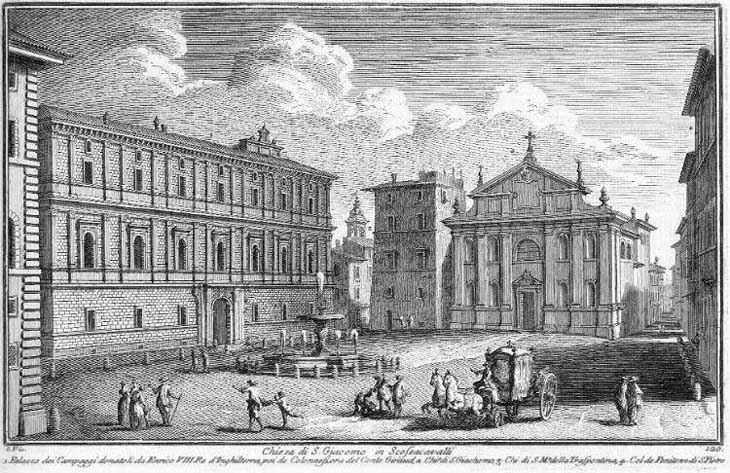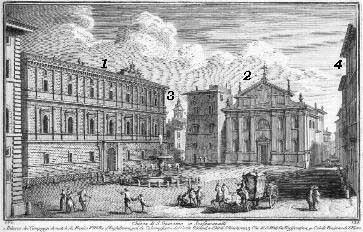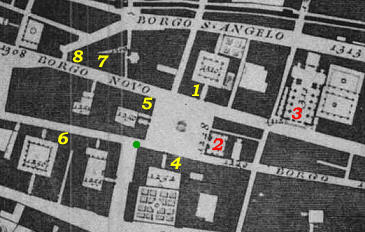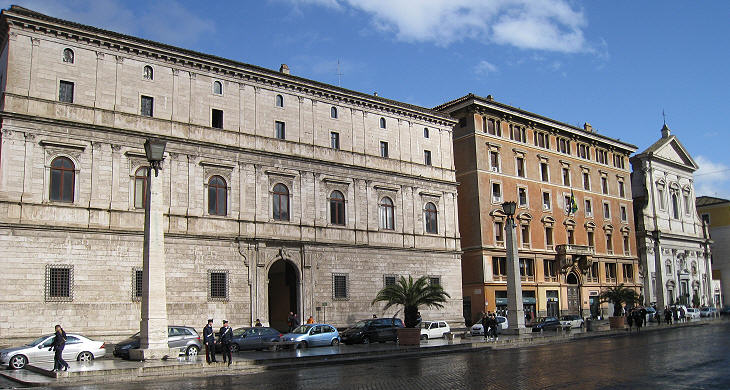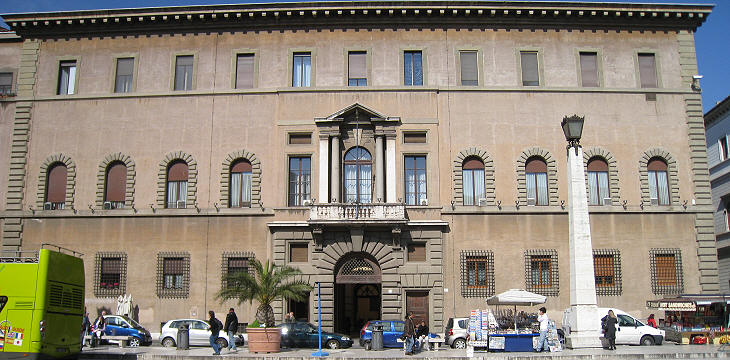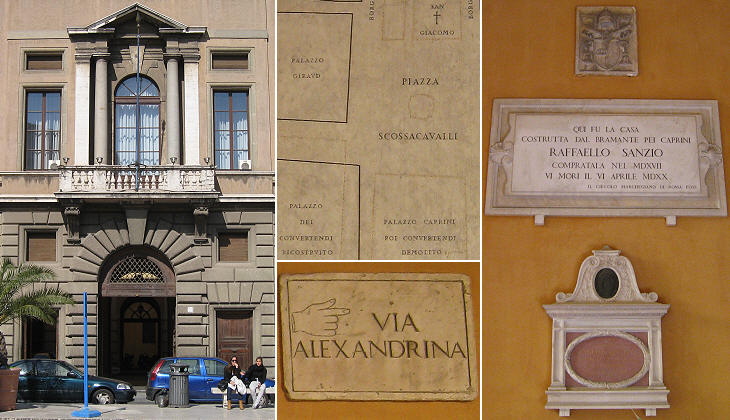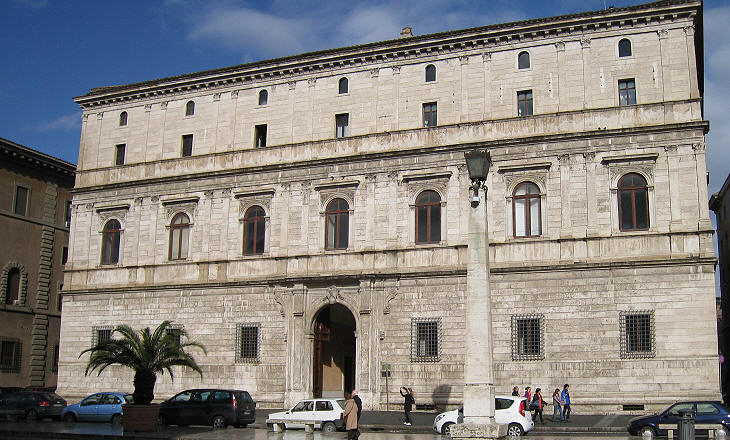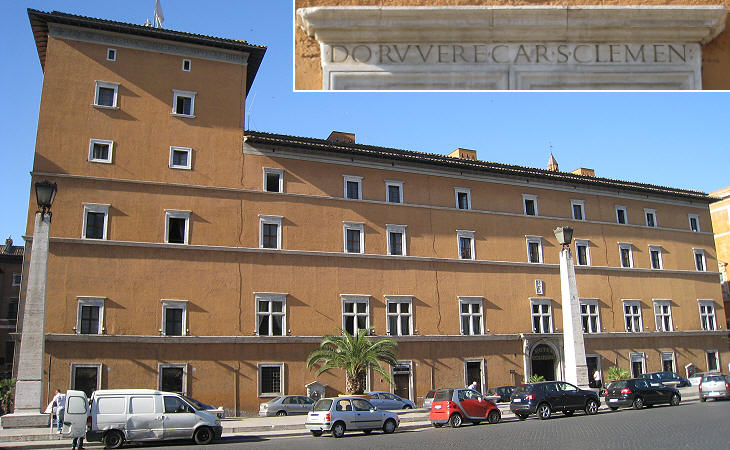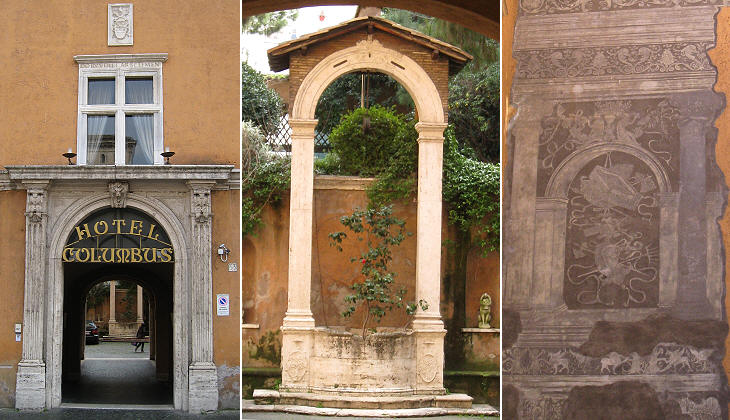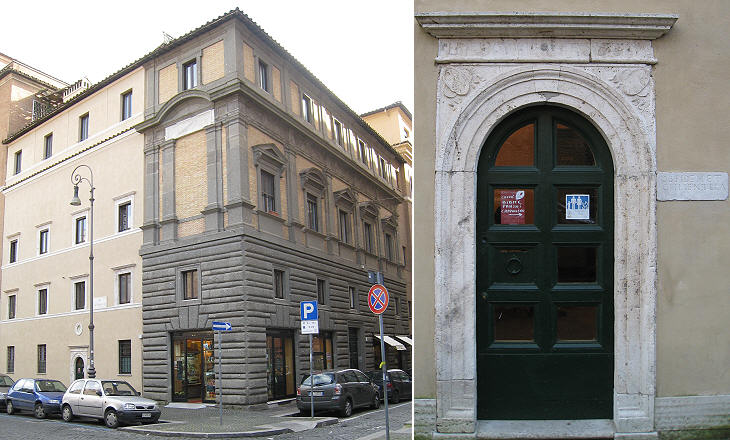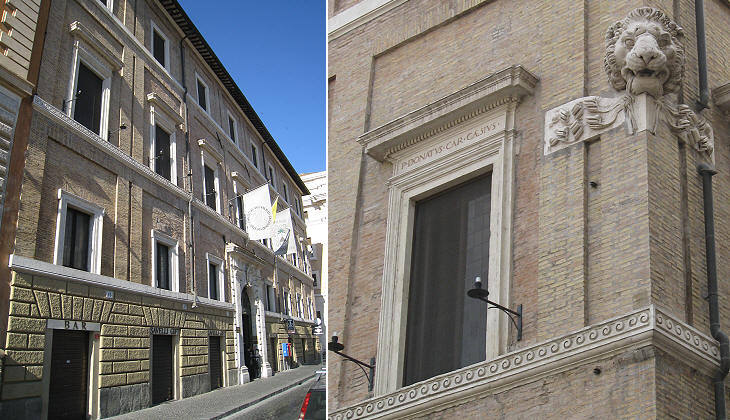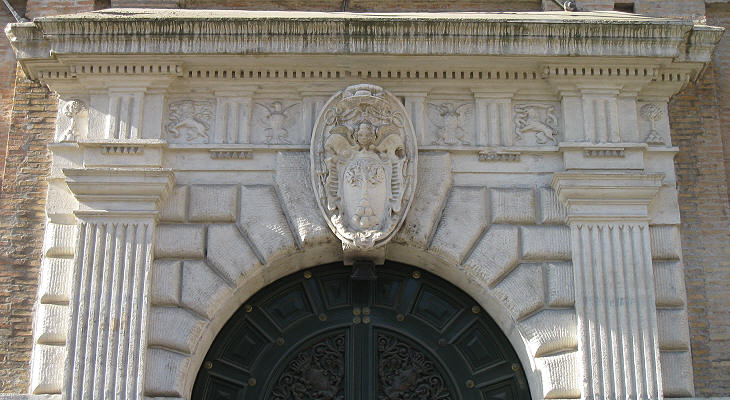  What's New! Detailed Sitemap All images © by Roberto Piperno, owner of the domain. Write to romapip@quipo.it. Text edited by Rosamie Moore. Page revised in March 2010. | S. Giacomo in Scossacavalli (Book 6) (Day 8) (View D3) (Rione Borgo)
In this page:
This view by Giuseppe Vasi shows Piazza Scossacavalli which until 1937 was the most important square of Rione Borgo, except for Piazza S. Pietro. It was given the shape we see in the etching between the end of the XVth century and that of the following century; it was located between Borgo Vecchio, a street linking Ponte S. Angelo with S. Pietro and Via Alessandrina (Borgo Nuovo), the new street parallel to Borgo Vecchio which was opened in 1499 by Pope Alexander VI; the pope granted benefits to those building imposing palaces along the new street and this led to the construction of Palazzo Giraud and Palazzo dei Convertendi. The origin of the name Scossacavalli is uncertain: some believe it is due to the fact that here the pilgrims dismounted (cavalli = horses) before going to S. Pietro. The view is taken from the green dot in the small 1748 map here below. In the description below the plate Vasi made reference to: 1) Palazzo Giraud; 2) S. Giacomo; 3) S. Maria della Traspontina; 4) Collegio de' Penitenzieri. 3) is shown in detail in another page. The small map shows also 5) Palazzo dei Convertendi; 6) Palazzo Cesi; 7) Casa di Febo Brigotti and 8) Casa di Jacopo da Brescia.
Today
Via della Conciliazione, a large street, was completed in 1950 to provide a grand approach to Piazza S. Pietro and also to celebrate the reconciliation between the Holy See and Italy after the 1870 events. All the buildings between Borgo Vecchio and Borgo Nuovo (including the church of S. Giacomo) were pulled down in 1937. The architectonic elements of some houses and palaces were carefully removed and their fašades were reconstructed in modern buildings at the sides of the new street. S. Giacomo a Scossacavalli was not deemed worth the effort of rebuilding it; its movable works of art were given to the Vatican, its relics to SS. Michele e Magno and the frescoes were detached and moved to Museo di Roma. The church was designed in the XVIth century on the site of a previous small medieval church. You may wish to see S. Giacomo a Scossacavalli in a 1588 Guide to Rome, a few years before the completion of the fašade. The fountain shown in the plate was built at the time of Pope Paul V and in 1958 it was relocated to S. Andrea della Valle. In order to relive the feelings pilgrims experienced when they reached Piazza S. Pietro through the old narrow streets, one can choose to walk along Borgo S. Spirito, rather than Via della Conciliazione. Palazzo dei Convertendi
Palazzo dei Convertendi acquired this name in 1685 when it was bequeathed by Cardinal Girolamo Gastaldi to an institution in charge of giving assistance to the converted heretics; prior to that year the building had belonged to a long series of landlords, including Raphael who lived there from 1517 until his death in 1520. The palace is also known as Palazzo Caprini, the family who built it at the beginning of the XVIth century; it was designed by Donato Bramante and its appearance was similar to that of Palazzo Vidoni; at that time however it was a much smaller building; it was enlarged and its design was greatly modified in the late XVIth century; the fašade along Via Alessandrina which had a portal and a balcony designed by Baldassarre Peruzzi was deemed to be of greater value than that in Piazza Scossacavalli and it was reconstructed along Via della Conciliazione.
Palazzo Giraud
Palazzo Giraud was spared by the changes made in 1937-50; it was built in the early XVIth century by Cardinal Adriano Castellesi da Corneto (the palace is also known as Palazzo Castellesi). Its construction however was slowed down by many dramatic events in the life of Cardinal Castellesi; he was made cardinal in 1503 by Pope Alexander VI; at that time he was an English citizen and he enjoyed the trust of King Henry VIII, to whom he donated the unfinished palace; relations between the two worsened in the following years and the king put pressure on Pope Leo X, who, already suspicious that the cardinal was plotting against him, deprived Castellesi of his title. In 1519 King Henry VIII donated the palace to Cardinal Lorenzo Campeggi, the last cardinal protector of England and a future member of the commission which excommunicated the king in 1535 (Palazzo Campeggi is another name for the building). After various changes of property in 1720 the palace was eventually bought by Count Pietro Giraud who added the current entrance; in 1820 the building passed to the Torlonia who still own it. A storey of the palace was rented for a long period of time to J. C. Heywood, a XIXth century American gentleman of highly cultivated literary taste, and author of several works ("Sforza" "Herodias" "Antonius" "Lady Merton, a tale of the Eternal City") which apparently have fallen into oblivion. For a long period the palace was thought to have been designed by Donato Bramante, but art historians are no longer of this opinion; whoever designed it he was influenced by Palazzo della Cancelleria. Palazzo dei Penitenzieri
Palazzo dei Penitenzieri (or Della Rovere) was located on the southern side of Piazza Scossacavalli along Borgo Vecchio and it was built between 1480 and 1490 before the other two palaces of the square. Its design reminds of Palazzo Venezia; its founder, Cardinal Domenico Della Rovere, was not a relative of Pope Sixtus IV (Francesco Della Rovere) who made him cardinal in 1478; Domenico Della Rovere was titular cardinal of S. Clemente so the inscription above the windows says DO(minicus della) RUVERE CAR(dinal of) S. CLEMEN(ti). In 1947-48 the palace was brought back to its XVth century appearance by an extensive restoration.
In 1501 Cardinal Della Rovere died; he left his palace to religious institutions: Spedale di S. Spirito, the Chapter of S. Pietro and the monastery of S. Maria del Popolo; the palace (or parts of it) was rented to cardinals and noblemen until 1655 when it was bought by the Penitenzieri, the priests in charge of confessing the pilgrims at S. Pietro and of imposing the appropriate penance (It. penitenza). Case di Febo Brigotti e di Jacopo da Brescia
A modern building in a side street was decorated with the fašades of two Renaissance houses
which were both pulled down to open Via della Conciliazione and which both belonged to doctors of the popes.
The house of Febo Brigotti (doctor of Pope Paul III) had a rather simple fašade with an arched entrance (the small inscription near the door shows the motto of the landlord "OB FIDEM ET CHLIENTELA (faith and clients)".
Palazzo Cesi is another palace which was affected by the opening of Via della Conciliazione; it was shortened (each storey had twelve windows) and the entrance was relocated. The palace was built by Francesco Armellini who was made cardinal by Pope Leo X; towards 1565 it was bought by Cardinal Pier Donato Cesi and his brother Angelo who was Bishop of Todi; they commissioned Martino Longhi the Elder an extensive renovation of the building.
Excerpts from Giuseppe Vasi 1761 Itinerary related to this page:
You have completed Book 6! Move to Book 7 - plate 121 - Monastero dei Monaci Lateranensi e Chiesa di S. Maria della Pace Next step in Day 8 itinerary: Piazza di S. Pietro |
